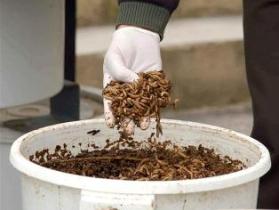Insects as animal feed commodity appears feasible

Because insects can turn low-grade biomass, such as all kinds of rest and by-products, into high-quality protein, they can be an interesting link in the feed chain and partly answer to the rising global demand for protein.
Wageningen University in The Netherlands early June conducted a workshop on the use of insects as feed ingredient. Main purpose of this meeting was to identify opportunities and obstacles to the widespread use of insects as a sustainable feed ingredient.
Approximately 50 participants, including insect breeders, feed companies, waste processors, risk assessors, researchers and others discussed the subject in Impulse, a new multipurpose facility on the campus of Wageningen University.
Gert van Duinkerken, chairman and head of the Animal Nutrition of Wageningen UR Livestock Research department, conducted a "final measurement" at the end of the meeting.
This showed that the participants almost unanimously believe that it is feasible to use insects on a large scale as a feed ingredient. Opinions varied about the time that this may become reality: already within 5 years or longer.
General expectation is that the use of insects as feedstock in the fish feed is closest to reality, and also in pet food.
However, there are real opportunities for the use of insects in poultry and swine.
Legal obstacles
The main obstacles that have to be removed are found in the field of legislation and regulations and in the speed of scaling up insect production and how cost reductions can be achieved.
The workshop is part of a feasibility study funded by the Dutch Ministry of Economics, Agriculture & Innovation and carried out by Wageningen UR Livestock Research and research groups "Product Design and Quality Management", "Animal Nutrition" and "Entomology" at Wageningen University. The final report of this is expected in late summer.
Insects can be applied not only in the fields of "feed", but also in the "food" and "pharmaceutical" area.
Early May in a workshop of the Insect Centre was thought about such uses of insects. Also in that meeting opportunities for developing new channels in which insects could be used as innovative links, were discussed.
The Insect Centre is a network connecting parties who wish to contribute to the successful introduction of insects in feed, food and pharmaceuticals. The aim is to gain a collaborative momentum that is greater than the single efforts of the contributing parties.











